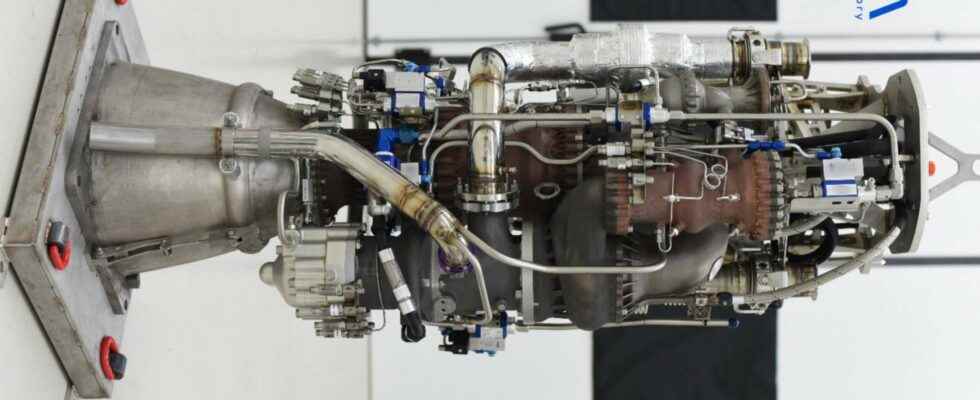FRG, for Rocket Factory Augsburg, is the name of this German start-up created in 2018. Objective: to enter the very promising market of small space launchers, and for this, the company has just unveiled its engine. A jewel of technology, based on a rare technology, inspired by the jewels of Soviet technology, brought up to date thanks to 3D printing.
You will also be interested
[EN VIDÉO] Rocket engines: how are they made? The development and construction of a space launch vehicle can take years, while its launch lasts only a few seconds. This event of rare intensity could not take place without appropriate engines. Discover in video how rocket engines are built, an essential element of every space launch.
Helix is the rocket engine developed by RFA, a start-up German company, which unveiled its latest creation on April 12 on the occasion of the Yuri’s Nightan international party to celebrate the anniversary of the first human in space, and the launch of the first american space shuttle.
A very well chosen opportunity since this new engine which will propel the company’s first rockets within a few months is based on a technology inspired by thrusters Soviets: the combustion layer rich in oxidant! Because yes, all rockets are similar on one point: you have to eject gas to move forward, but there is more than one way to do it!
Oxidizer-rich staged combustiona European first!
Let’s understand how the engine works: a starter injects gas (helium or nitrogen) into a turbine to initiate the rotation of a pump — gas which is then ejected through an exhaust parallel to the nozzle.
This pump is used to draw fuel from the tanks to the combustion chamber of the motor. In this combustion chamber a mixture of triethylaluminum-triethylborane (TEA-TEB) ignites and serves as ignition for the main combustion of the kerosene which makes the rocket fly — an ignition procedure also unprecedented in Europe!
But, in order for the pump to continue to run, part of the fuel is first injected into a pre-chamber to achieve incomplete combustion in order to power the turbine (and therefore to take over from the starter) which is used to turn said pump… and the circle is complete! The mixture from the pre-chamber is then reinjected into the main chamber to complete the combustion, it is a closed cycle.
It is the staged combustion, a first in Europe since the first tests of the firm last July. However, the prowess does not stop there.
Last July, we successfully tested our in-house developed #Helix engine for the first time. Now that the first engine in flight configuration is ready, we are preparing for a long duration hot fire test. Stay tuned on that, it’s going to be spectacular! (5/6) pic.twitter.com/GZp5FVlvXM
— Rocket Factory Augsburg (@rfa_space) April 12, 2022
This incomplete combustion in the pre-chamber may be too rich in fuel (known as fuel-rich, in English), it is a technique that ended up on the space shuttle, or on Japanese or Indian engines. But it can also be too rich in oxidizer (oxidizer-rich). This option generates a lot of corrosion and constraints on the mechanical components, which is why this technology, much studied in the 1960s, remained rare, and exclusive to Soviet know-how, as on the NK-33 engines which propelled the N1 rocket, which should have taken the Soviets on the Moon.
Today, this propulsion process has been exported to China on several Longue-March rockets and for just a few years to the United States where it is found on the BE-4 engine which will propel the future Vulcan rocket. From now on, it is done in Europe also thanks to the Augsburg start-up.
Objective, the space market of tomorrow
This Helix engine is for the company’s light launch vehicle which will be sent by nine examples of the thruster, enough to tear 92 tons from the earth’s soil and place 1.6 tons of payload in orbit. Thanks to the staged combustion, the rocket will not only be very powerful but also very efficient with a specific impulse of 325 seconds, which puts it quite high among the best kerosene rocket engines in the world.
It is designed in part by the3d printingin particular at the level of cooling pipes, a solution increasingly adopted by new players in the space sector to reduce costs and simplify manufacturing processes, like the French company Venture Orbital Systems, which also designs rockets whose engines will be fully 3D printed.
This development is part of the new dynamic of new space which will mark the next decade with a whole new market of small launchers and small, very low-cost, dynamic satellites that national space agencies are very fond of.
What you must remember
- RFA is a German startup, located in Augsburg, which designs rockets;
- Helix is the first European staged combustion rocket engine rich in oxidizer, a powerful but very complex technology;
- The engine benefits from 3D printing to meet the objectives of the new market for small space launchers.
Interested in what you just read?
